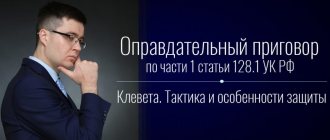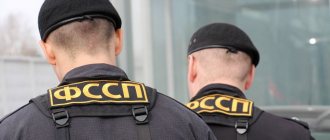When there can be no assassination attempt
The victim does not always react calmly to actions directed at her and may use force in response. If this happens, and the strength of the victim exceeds the strength of the offender, then it is incorrect to talk about an attempt. In this case, the act on the part of the victim is considered as an excess of necessary defense, as a result of which the victim herself may end up in the dock.
Another case is causing the death of the victim. If the criminal, in the course of implementing his plan, accidentally killed the victim, then another article will be charged, and the punishment will be appropriate. The investigator will need to reclassify the act.
If a criminal during an attempt killed a law enforcement officer, then Article 105 of the Criminal Code of the Russian Federation does not apply to him; his act is qualified according to another norm. In this case, we can talk about the absence of an attempt and the presence of another crime.
In the listed cases, it is incorrect to talk about the imputation of the article on the attempt, from a legal and legal point of view.
PRACTICAL LESSON No. 18 Solving problems on the topic
PRACTICAL LESSON No. 16 Solving problems on the topic
"Criminal responsibility of minors"
1. Which persons are recognized as minors under the Criminal Code of the Russian Federation?
Answer: Minors are those who were fourteen years old at the time of committing the crime, but not eighteen years old.
2. What date is considered the birthday of the guilty person when a forensic medical examination determines his age to the nearest year?
Answer: When establishing age through a forensic medical examination, the birthday of the culprit should be considered the last day of the year determined by experts.
3. List the types of criminal penalties that cannot be applied to minors.
Answer:
· deprivation of a special, military or honorary title, class rank and state awards;
· restrictions on military service;
· forced labor;
· arrest;
· detention in a disciplinary military unit;
· life imprisonment;
· the death penalty.
4. At what point is a minor considered to have reached a certain age?
Answer: A person is considered to have reached the age at which criminal liability begins, not on his birthday, but after its expiration, i.e. from zero o'clock the next day.
5. For how long can a minor be sentenced to imprisonment?
Answer: Punishment in the form of imprisonment is imposed on convicted minors under the age of 16, for a period of not more than 6 years. At the age of 14 to 16, for especially serious crimes - up to 10 years. When a convicted minor is sentenced to imprisonment for committing a serious or especially serious crime, the lower limit of punishment provided for by the relevant article of the Criminal Code of the Russian Federation is reduced by half. Imprisonment is served by minors in educational colonies.
6. How can compulsory educational measures be applied to minors?
Answer: Compulsory educational measures are applied to minors as a sanction.
Practical part. The solution of the problem.
Problem No. 2
15-year-old Soev, on the landing late at night, tried to rape his classmate Vavilova, who, having escaped from the rapist, hid in the attic of this house. Soev went up to the attic and began to pursue Vavilova. Fleeing from persecution, Vavilova climbed out through a dormer window (which was under major renovation) onto the roof of a 3-story building, tripped, fell from the roof of the house and died.
Resolve the issue of Soev's criminal liability. Check out Art. Art. 20, 30, 131 CC. Determine Soev's punishment.
Answer: In accordance with Part 2 of Art. 20 of the Criminal Code of the Russian Federation, 15-year-old Soev is subject to criminal liability and Soev’s actions must be qualified as attempted rape, which negligently resulted in the death of the victim (Article 30, Part 3; Article 131, Part 4, Clause “a” of the Criminal Code of the Russian Federation). Impose punishment in the form of restriction of freedom for 2 years.
PRACTICAL LESSON No. 17 Studying the rules for applying compulsory medical measures
Answers to questions to reinforce theoretical material:
1. Define compulsory medical measures?
Answer: Compulsory medical measures are measures provided for by criminal law that are applied to persons suffering from mental illness who have committed a socially dangerous act or crime, in order to cure them or improve their mental state, as well as prevent antisocial behavior.
2. To whom can compulsory medical measures be applied?
Answer: Compulsory medical measures may be imposed by the court on the following persons:
a) who committed acts provided for in the articles of the Special Part of this Code in a state of insanity;
b) who, after committing a crime, have developed a mental disorder that makes it impossible to impose or carry out punishment;
c) who have committed a crime and suffer from mental disorders that do not exclude sanity;
e) who, at the age of over eighteen, have committed a crime against the sexual integrity of a minor under fourteen years of age, and who suffer from a disorder of sexual preference (pedophilia), which does not exclude sanity.
3. Name and disclose the types of compulsory medical measures?
Answer :
— Compulsory outpatient observation and treatment by a psychiatrist - if the patient does not need inpatient treatment
(Outpatient treatment presupposes that a psychiatrist regularly examines the patient and prescribes medication. Such medical measures are applied to sane persons, but who have behavioral disorders such as, for example, personality disorders, neurotic conditions, and mild forms of mental retardation.) ;
— Treatment in a general psychiatric hospital - if the patient needs hospitalization, but does not require an intensive course of treatment
(General hospitals are psychiatric hospitals in which persons who have committed crimes are kept together with persons with mental illnesses. The only difference between them is that criminals do not receive leave and the opportunity to freely leave the hospital);
— Treatment in a specialized psychiatric hospital – if the patient requires constant observation in a hospital
(In a specialized regime hospital there are persons prone to escape, persons with alcohol addiction, as well as those who are not the first to commit criminal acts.);
— Treatment in a specialized psychiatric hospital with intensive observation - if the patient is recognized as posing a particular danger to society and requires constant monitoring and intensive treatment
(During intensive treatment, additional security is provided by police officers to ensure the safety of doctors and other patients in hospitals. This is due to the fact that persons held in such conditions are aggressive, difficult to treat and often attack hospital staff).
4. In what cases are compulsory medical measures imposed on persons who have committed acts provided for in the articles of the Special Part of the Criminal Code of the Russian Federation in a state of insanity?
Answer: Persons specified in part one of this article are prescribed compulsory medical measures only in cases where mental disorders are associated with the possibility of these persons causing other significant harm or danger to themselves or other persons.
5. Which person can be assigned compulsory treatment in a general psychiatric hospital?
Answer: Compulsory treatment in a medical organization providing psychiatric care in an inpatient setting, of a general type, can be prescribed to a person whose mental state requires treatment and observation in an inpatient setting, but does not require intensive supervision.
Practical part. The solution of the problem.
Task No. 1
Vafin was sentenced to imprisonment for 7 years with deprivation of the right to drive a vehicle for 2 years for car theft and violation of traffic rules, which negligently resulted in the death of 1 person and the infliction of grievous bodily harm on 2 citizens. While serving his sentence in prison, he fell ill with a chronic mental illness, which deprived him of the ability to account for and manage his actions. At the time of illness, they had not served 2 years, 1 month and 22 days of imprisonment.
What should the administration of the correctional colony do in connection with Vafin’s illness? What decision should be made according to the law?
Decision: Based on Art. 21 of the Criminal Code of the Russian Federation, the administration of the correctional colony needs to transfer Vafin to a medical institution due to illness and impose compulsory medical measures.
PRACTICAL LESSON No. 18 Solving problems on the topic
"Crimes against life"
The generic object of all crimes included in this section are social relations that ensure the normal functioning of the individual.
The specific (group) object of crimes provided for in Chapter 16 of the Criminal Code of the Russian Federation is such inalienable benefits of the individual as the right to life and health.
The theory of criminal law adheres to the following classification of crimes against life and health:
1. Crimes against life
:
- Art. 105 of the Criminal Code of the Russian Federation “Murder”;
- Art. Art. 106-108 of the Criminal Code of the Russian Federation (murder with mitigating circumstances);
- Art. 109 of the Criminal Code of the Russian Federation “Causing death by negligence”;
- Art. 110 of the Criminal Code of the Russian Federation “Incitement to suicide.”
2. Crimes against health
:
Art. Art. 111-118 of the Criminal Code of the Russian Federation (causing harm to health of varying severity, torture and beatings).
3. Crimes that endanger life and health
:
· art. 119 of the Criminal Code of the Russian Federation “Threat of murder or infliction of grievous bodily harm”;
· art. 120 of the Criminal Code of the Russian Federation “Forcing to remove organs or tissues for transplantation”;
· art. 121 of the Criminal Code of the Russian Federation “Infection with venereal disease”;
· art. 122 of the Criminal Code of the Russian Federation “Infection with HIV infection”;
· art. 123 of the Criminal Code of the Russian Federation “Illegal abortion”;
· art. 124 of the Criminal Code of the Russian Federation “Failure to provide assistance to a patient”;
· art. 125 of the Criminal Code of the Russian Federation “Leaving in danger.”
From the objective side, crimes can be committed:
o action and inaction (Articles 105, 106, 111, 112, 115 of the Criminal Code of the Russian Federation);
o only by action (Articles 107, 108, 109, 110, 113, 114, 116-120, 123 of the Criminal Code of the Russian Federation);
o only by inaction (Articles 121, 122, 124, 125 of the Criminal Code of the Russian Federation).
The subject of these acts can be both general (Articles 107-110, 113-123 of the Criminal Code of the Russian Federation) and special: age 14 years (Articles 105, 111, 112 of the Criminal Code of the Russian Federation);
The subjective side is predominantly an intentional form of guilt (Articles 105-108, 110-117, 119-125 of the Criminal Code of the Russian Federation), some offenses provide for a careless form (Articles 109, 118 of the Criminal Code of the Russian Federation).
In general, crimes of Chapter 16 have an increased degree of public danger, since they encroach on the inherent benefits of a person: life, health and their safety.
Privileged crimes:
§ Art. 106 – “Murder of a newborn child by a mother”;
§ Art. 107 – “Murder committed in a state of passion”;
§ Art. 108 – “Murder committed by exceeding the limits of necessary defense or by exceeding the measures necessary to apprehend the person who committed the crime”
§ Art. 113 – “Causing grievous or moderate harm to health in a state of passion”
§ Art. 114 – “Causing grievous or moderate harm to health by exceeding the limits of necessary defense or by exceeding the measures necessary to detain the person who committed the crime.”
Practical part. The solution of the problem.
Task No. 1
In order to kill the husband of his mistress Pavlova G., Efremov suggested that Grinev commit the murder of Boris Pavlov, for which he promised to pay him 140 thousand rubles. When Pavlova G. was on night duty, Grinev came to Pavlov B. in a medical gown and said that his wife was in the hospital and, if he wished, they would take him to the hospital by car. Palov B. agreed to go, went out into the street with Grinev, where he was seated in the back seat between Grinev and Efremov. The Lada 21099 was driven by Nilov, next to the driver was the 4th member of the group, Kolintsev, to whom Grinev had informed the day before that they were going to “get even with one here.” As soon as Pavlov B. got into the car, Grinev commanded: “Hands behind your back!” and handcuffed him. They put a plastic bag on Pavlov B.’s head and tied it with a rubber band. A few minutes later, Pavlov B. suffocated.
The victims' corpse was thrown into a sewer manhole by the participants in the murder. Efremov immediately gave Grinev 140 thousand rubles at the car.
Conduct a legal analysis of the elements of murder and a description of the qualifying circumstances.
Qualify the actions of these persons.
Decision: The actions of Efremov and Grinev must be qualified within the framework of Article 105 of the Criminal Code of the Russian Federation. The actions of Nilov and Kolintsev do not constitute a crime.
The object of this crime is the life of Pavlov B. Murder is an act with a material composition .
The objective side of this crime was committed in the form of an active action. In this case, it was expressed in putting a bag on the victim’s head and preventing oxygen from entering the body, which in turn led to the consequences - the death of the victim. There is a direct cause-and-effect relationship between the act and the consequence .
The subjective side of this crime is characterized by a deliberate form of guilt. The intent is direct.
In this case, the “motive” “for hire” is seen in relation to Grinev and Efimtsev and is a mandatory feature influencing qualifications.
The subjects of the crime (Grinev and Efremov) are natural, sane persons who have reached the legal age (according to Article 105 - from 14 years old).
A murder committed by a group of persons, by a group of persons by prior conspiracy (clause “g”, part 2 of article 105 of the Criminal Code) , is committed using various forms of complicity. Like any complicity, it involves the deliberate participation of two or more persons in taking the life of another person.
In accordance with Part 2 of Art. 33 of the Criminal Code of the Russian Federation “The perpetrator is the person who directly committed the crime,” such a person who committed active actions that led to Pavlov’s death is Grinev.
According to Part 4 of Article 33 of the Criminal Code of the Russian Federation, “An instigator is a person who has persuaded another person to commit a crime.”
Instigator of crime
- a person who has deliberately aroused in the mind of another person the determination to commit a specific crime. In this case, Efremov, promising to pay Grinev money in the amount of 140 thousand rubles (i.e. using bribery), aroused in him the determination to deliberately commit the murder of Pavlov.
When qualifying, it is necessary to note that after Pavlov got into the car, Grinev handcuffed him (with his hands in the “behind” position), thereby depriving him of the opportunity to resist and putting him in a helpless state.
Also, Grinev’s actions fall under the heading of “Murder for Hire” (clause “h” of Part 2 of Article 105 of the Criminal Code), because it is conditioned by the receipt by the perpetrator of the crime of material reward (140 rubles from Efremov).
Thus, Efremov’s actions are qualified under clauses “g,z”, part 2 of Article 105 of the Criminal Code of the Russian Federation with reference to part 4 of Article 33 of the Criminal Code of the Russian Federation. Grinev’s actions are qualified under clauses “v,g,z” Part 2 of Article 105 of the Criminal Code of the Russian Federation There is no corpus delicti in the actions of Nilov and Kolintsev.
Qualification of the crime
The Criminal Code of the Russian Federation classifies assassination into completed and unfinished. In the first case, the attacker completes all planned actions, but the desired result never occurs. In the second case, the criminal simply did not have time to complete all the planned stages, as he was interrupted by certain circumstances.
An example of a completed assassination attempt is a situation in which citizen Sidorov decided to kill two older brothers because of an inheritance. He fired two shots in turn from the pistol, each of which was intended separately for each of the brothers. As a result of the shootout, one of the brothers died, and the second ended up in the hospital, where he was provided with assistance. The criminal did everything possible on his own behalf, but the desired result did not occur due to timely medical assistance provided to one of the brothers.
An example of an unfinished attempted murder would be a situation in which a new mother decided to drown her child and threw him into the bath, but then the local pediatrician knocked on the door, asking to see the child. The mother was forced to interrupt the crime and pull the child out of the water.
The article of the Criminal Code of the Russian Federation also regulates attempts on human life in a state of passion. This moment is considered to alleviate a person’s guilt, but cannot completely relieve him from punishment. For example, a guy suffered for a long time from insults and bullying from his classmates. One day he caught one of the offenders composing an indecent poem on the asphalt in front of his entrance. Unable to bear it, the guy rushed after his offender, and, having caught up with him, smashed his head with a cobblestone that was lying nearby. The guy will be held accountable for attempted murder in a state of passion, that is, under Art. 30 part 3 and part 1 art. 107 of the Criminal Code of the Russian Federation.
An attempt on life can be carried out with an unsuitable crime weapon. In criminal law, this situation is called an inappropriate attempted murder, that is, an attempt to take a person’s life is carried out with a weapon that, in principle, is not capable of taking a life.
For example, a wife, tired of her husband’s insults, grabbed a faulty firearm and tried to finish him off, or added medications to his food, which she perceived as poison, although in fact, the medications were not such.
The concept of attempted crime and its types
Article for murder with extreme cruelty
Let's start with this definition. Article 105 of the Criminal Code of the Russian Federation is divided into paragraphs and subparagraphs. The first is intentionally causing the death of another person. Punishable by a term of imprisonment from 6 to 15 years with or without restriction of freedom for up to two years.
The second paragraph includes 13 subparagraphs. These are aggravating circumstances. Among them, for example, is the murder of two or more persons, associated with the kidnapping of a person, motivated by blood feud, from hooligan motives, in a generally dangerous manner, etc. Here under the letter “d” - with particular cruelty. Murders falling under the second count are punishable by imprisonment for a term of 8 to 20 years. Also, at the discretion of the court or jury, it is possible to impose a life sentence. The prisoners are sent to a maximum security colony.
Murder with extreme cruelty: Article 105 of the Criminal Code of the Russian Federation, part 2, paragraph “e”.
Problems of differentiation from other crimes
It is often easy to confuse the articles and impose a punishment that is not what the accused deserves. In this case, we can talk about the problems of distinguishing crimes. Therefore, when qualifying an act, you need to carefully study the available evidence and evidence in order to choose the right article.
Such compositions include:
- Death threat. In this case, it would be incorrect to talk about an assassination attempt. Here there is only a threat of violence, that is, the criminal does not take action, but only talks about what he can do in theory.
- Serious injuries to the body. Such an act should also be distinguished from an assault, since here the actions are aimed at killing, but the offender did not complete it due to certain circumstances.
- Getting things done. The criminal is not always given the opportunity to bring his plan to its logical conclusion. This may be due to a number of factors, which may depend on the perpetrator or force majeure.
Important! The correct definition of the composition is the key to the correct classification of the crime, which determines the assignment of the punishment that the offender actually deserves.





